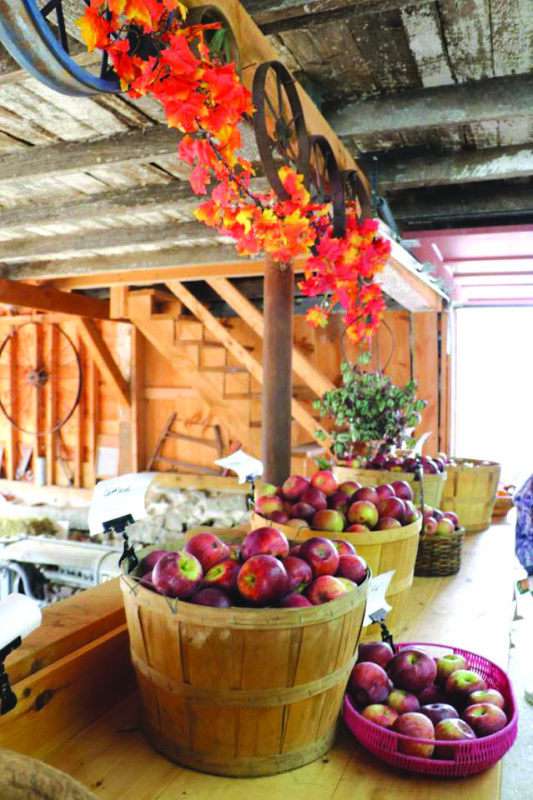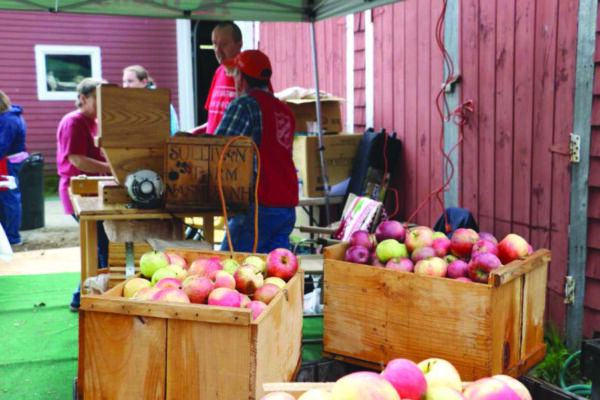27 PERFORMERS AND BANDS TALK ABOUT THE LOCAL SCENE, FELLOW MUSICIANS AND THE UPCOMING NEW ENGLAND MUSIC AWARDS
When the annual New England Music Awards ceremony takes place on Sunday, Oct. 17, New Hampshire will be well-represented, with a slate of dozens of nominees. The Hippo reached out to many of them, and 27 responded, sharing their thoughts on their nominations and what it’s like to be part of the local music scene.
New Hampshire’s Soundtrack
Michael Witthaus built a Spotify playlist highlighting the artists here. Find it by searching for him or “New England Music Awards 2021 — Representing New Hampshire” on Spotify. As Dead Harrison put it when asked about favorites among this year’s nominees: “There are so many excellent people here. Carissa Johnson, Liz Bills, Hunter, Jennifer Tefft, Major Moment, Mindset X, SixteenX20, Sepsiss, Walter Sickert … all of them are great…. Even still, there are so many nominees that I haven’t even discovered yet. You all need to go get some wholesome music into your earholes.”
Amanda McCarthy
Female Performer of the Year
On being nominated: Grateful … but also a little surprised, since I now reside primarily in Nashville. However, I do strive to remain active in New England and perform regularly when I visit home, so I was really happy to see that be recognized. The first time I was nominated, in 2019, I’d had zero expectations and I was truly shocked.
On NEMA’s importance: Awards are a funny thing in music. I don’t think they are or should be the end-all-be-all of what any musician does. That being said, it always feels good to be recognized and these nominations/wins definitely make a resume look better, which helps with bookings and getting bigger opportunities.
On her category: I haven’t really released new music since the last awards cycle, but I have continued to perform music for a living despite the Covid challenges, so I think it was actually the perfect category this time around.
On being a New England musician: It’s very easy to travel to different areas and make the rounds… There’s opportunity [to play] original music, but also work the covers scene for money. While I do feel Nashville is the place for me to be at this time as a songwriter, I fully credit New England for allowing the chances to develop my career … and I always look forward to coming back.
Upcoming shows: In New England on Saturday, Oct. 16, and Monday, Oct. 18, locations TBA
Bitter Pill
Live Act of the Year, Best in State
On being nominated: [The band, led by father-daughter duo Billy and Emily Butler, answered together via email] Billy said, H, look at that,’ sipped his coffee and pulled on a spliff, while Emily said, “Weeeeee!”
On NEMA’s importance: Awards are not important to us but we do love the community aspect of it. Celebrating original music from our region is something we feel is very important.
On their category: We were nominated for Best Live Act and Best of New Hampshire. That’s pretty cool. We love playing live and our audiences eat up our silliness, fun and love.
On being New England musicians: New England audiences love live original music. Also there is something in the air here in the North Country, especially the original music. Maybe it’s the four seasons or the deeply rooted working-class journeyman history. It’s one of the reasons we call ourselves Bitter Pill. It is hard living in the winter but when spring comes, that pill isn’t so hard to swallow.
Upcoming shows: Claremont Opera House, Saturday, Oct. 23
Charlie Chronopoulos
Album of the Year – Chesty Rollins’ Dead End
On being nominated: I’m honored. There are a lot of really awesome people making albums around here, so to be included in that conversation is a wonderful thing.
On NEMA’s importance:I’ve followed the awards over the years often voting for friends. I’ve found some really great music after looking into some of the other nominees I didn’t know. It’s a really great thing they’re doing in the community even just helping artists find one another.
On his category: Album of the year is my favorite category. It’s what I’m most interested in, so I’m glad to be there.
On being a New England musician: It has many upsides. You can afford studio space if you’re willing to look around off the beaten path. You can make friends for life in sleepy towns who don’t move away like friends in the city tend to. You can find a swimming hole on the way to a gig. Stuff like that makes it worth leaning into this community for sure.
Upcoming shows: Currier Museum of Art, Thursday, Oct. 28
“He’s the real deal. Definitely lived and done the thing and his writing really reflects that.”
Charlie Chronopoulos on Tyler Allgood
Dakota Smart
New Act of the Year and Best in State
On being nominated: When I found out, I felt humbled and in disbelief. I realize there’s a lot of talented artists in New England, and it’s an honor to be on a list with them. My first response was to thank the New England Music Awards, and to congratulate fellow musicians and producers who were also nominated. Then I encouraged my family, friends and fans to vote.
On NEMA’s importance: They are a huge deal to me. I live and breathe to write music and perform. I’ve been writing songs since I was 10 years old. My life’s passion is to produce music that has a positive impact and is enjoyed by people of all ages … to win would really help to spotlight my work, and provide an outlet for my music to be heard.
On his category: The two categories fit my level of work to date. Although I’ve been performing for years, this year I launched. My newest 12-song professional album is the best I’ve ever written, and I’m the most confident on stage I’ve ever been. … I feel this is the year that my career really has a chance to take off.
On being a New England musician: The music scene in New England is very supportive. It’s a small community that’s very inclusive of artists from various backgrounds and styles. Also, the venues are very open to live music, and that keeps us working.
“I’ve had the opportunity to collaborate with him in the past. He’s extremely talented, has a unique style, and is a pleasure to work with.”
Dakota Smart on Senie Hunt
David Corson
Best in State
On being nominated: My first response was actually shock. … I was scrolling through the nominees trying to see which bands I knew personally had been nominated and randomly saw my name. I was ecstatic, because I have been working really hard at this for a long time.
On NEMA’s importance: The awards are extremely important to every musician in this area because it gives us validation that all of our grinding has amounted to something. It also helps us get more gigs, because it looks great on our resume.
On his category: I have been playing music in New Hampshire and the surrounding area since I was 18, so being nominated for best in the state feels so good; almost 10 years of work is finally paying off.
On being a New England musician: I would say the best thing about being a New England musician is the community that I’m surrounded by. The musicians and the audiences create an atmosphere of acceptance and appreciation of all types of music.
Upcoming shows: Cara Irish Pub in Dover on Friday, Oct. 1; Dwyer’s Pub in Portsmouth on Wednesdays in October; Tailgate Tavern in Stratham on Friday, Oct. 8; Shane’s Backyard in Hampton on Friday, Oct. 15; Sawbelly Brewing in Exeter on Saturday, Oct. 16
Dead Harrison
Best in State
On being nominated: Our first nomination in 2019 … struck us with great hope. Even if we weren’t going to win, it gave us something to strive for. Now we’re on our third year [and] all the love and support from our community is so empowering and makes us push even harder to just do what we love to do, to make more and better music than the year before.
On NEMA’s importance: It sheds light on all those musicians around the New England area. There is so much talent that the majority of the public doesn’t see. It puts a little perspective to how hard people work [at] being a musician. It gives a musician hope. It helps us to never give up, and be better than you were at the gig before.
On their category: I don’t think we have ever felt that we were the best act in New Hampshire, but it is such a high honor to hold close to the heart. The past year and a half has been tough on us all. We all work so hard, and there are so many great bands out there keeping the fires lit. I feel it helps keep people inspired.
On being a New England musician: New England musicians have a strong work ethic and don’t give up easily. Not only that, but the community of other musicians has always been a supportive one. Always be encouraging. Always be truthful and don’t let pride be your downfall. We strive to be helpful, not hurtful. We push each other to be the best we can be, and then push a little further.
Upcoming shows: Octoberfest at Lithermans Limited, Concord, Saturday, Oct. 16, and Sinfest at Jewel, Manchester, Saturday, Nov. 13
DJ Midas
Digital Performer
On being nominated: I got a message from a friend/fan from Nashua who wrote, ‘I voted for you.’ I had no idea if it was a weird joke, a compliment or insult. I asked him what he meant and he sent me the link. I wasn’t familiar with the New England Music Awards, so I was initially skeptical as to what it was.
On NEMA’s importance: As a fairly off the beaten path type of artist, it is really heartwarming to know there are people out there that appreciate and recognize my efforts.
On his category: After spending so many years on vinyl and transitioning into the digital word only in the last decade, it feels pretty damn good.
On being a New England musician: I love [the] sparky New England attitude. I love that there is still breathing room in our area to be yourself.
Upcoming shows: Late Night Delight with Midas on 95.3 WMNH every Saturday and Sunday at midnight; Vice 80’s party at 603 Bar and Lounge in Dover on Saturday, Oct. 16
“I love Roots Of Creation; they end the rules, and sound so juicy.”
DJ Midas on Roots of Creation
Fil Pacino
Male Performer of the Year
On being nominated: Surprised. I’m not normally considered for such things and I found out from a friend a few days after nominees were announced.
On NEMA’s importance: The majority of what I do operates in the covers/GB scene. I do write, record and perform a lot of my own music, which can be found on all the streaming media and my website, but I’ve done OK with having not received any accolades in the past.
On his category: Well, I am a male and I perform pretty much every day of the year, so I think they nailed it.
On being a New England musician: There’s a lot of opportunity. I love that it’s a genre melting pot, and who doesn’t love getting to play music in all four seasons?
Upcoming shows: filpacino.com
Hunter
Best in State
On being nominated: I’m surprised and grateful.
On NEMA’s importance: I’m always going to be doing music and giving it my all, but it’s a really cool thing to have recognition for that work and energy spent.
On their category: There are so many good bands in every category and I’m blessed to know most of them. I love being nominated for best in state because I’ve worked really hard to represent New Hampshire with the band. I hope to be in performer of the year or female performer of the year because I do primarily think of myself as a performer and entertainer more than a musician.
On being a New England musician: I love the community of it in most areas — the support shared between the musicians and bands, sharing each other’s stuff, helping each other get gigs, and how we stay in touch and play shows together.
Upcoming shows: Portsmouth Feed Co., Portsmouth, Saturday, Oct. 9
Justin Cohn
Best in State
On being nominated: I was surprised. I’ve checked the nominations the last few years the day they’ve come out … this year I didn’t, assuming I wouldn’t get a nomination. A friend reached out to me and congratulated me; that’s how I found out. It’s an honor.
On NEMA’s importance: To be included as a nominee with a bunch of incredibly talented New England musicians for whom I have so much respect is very affirming. I play a lot of cover gigs to pay the bills, and while I’m so grateful to the venues that book me, it means a lot to be recognized as a musician in this vibrant creative community.
On his category: It is a meaningful category for me. I was born and raised here, and my roots will always be here. No matter where this career takes me, it would be an honor to win that award. Just to be nominated is an honor.
On being a New England musician: We have a lot of quality, original artists up here, and I love being in that community. That’s not to say other parts of the country don’t, but in my traveling and my conversations with friends, I think we have something special up here. Maybe it’s the four distinct seasons, maybe it’s the history. Whatever it is, I enjoy being a small part of it.
Upcoming shows: Hippy Hollow House Show in Greenville on Saturday, Oct. 2; Milford Pumpkin Festival in Milford on Saturday, Oct. 9; Square Root in Boston (opening for Cat Attic) on Friday, Oct. 15
Katie Dobbins
Best in State
On being nominated: I feel especially stoked … because it has been such a crazy time for musicians; you can start to feel nervous about losing momentum. So it’s nice to see that people are still excited about what I’m doing.
On NEMA’s importance: My success depends on me; that has really helped me deal with the inevitable rejection we all face in this industry. But of course being nominated helps build my musical resume, and I think it helps people take me more seriously. It does boost my confidence as well, which helps me feel like I’m on the right track.
On her category: It feels really great because New Hampshire is where I was born and raised, where I have continued to have an ongoing presence throughout my music career … it’s validation that I’m in the right place and that people are cheering me on. It’s also interesting because there are a lot of amazing New Hampshire artists that I look up to who didn’t make the list.
On being a New England musician: I have found the music community here to be so supportive. I’ve made a lot of very close friends in the industry, and in my experience everyone really wants to help each other out. We celebrate one another’s successes, we help one another get new opportunities. I don’t know that it’s like that everywhere; I’m grateful. … Nashville definitely has a piece of my heart, but there’s nothing like coming back home to New England.
Upcoming shows: Community Fest at The Belknap Mill, Gilford, Saturday, Oct. 16
Liz Bills
Female and Digital Performer, Pop Act, Song and Video of the Year – “WiHi”
On being nominated: I was honestly shocked to be nominated for so many awards.
On NEMA’s importance: The nominations and awards look great on the resume, and it helps with networking and connections.
On her category: I’m grateful to be nominated in five categories. It means the world to me to be nominated for female performer of the year because I feel that performing is one of my strongest abilities. It’s so funny, in a good way, to be nominated for pop act of the year because I won roots act of the year and rock act of the year in the past. It just goes to show you how difficult it is to categorize my genre, and I love that.
On being a New England musician: I love how close we are to neighboring states, making tours pretty sweet and easy. I am a New England girl born and raised, so it feels good to have roots here in music.
Upcoming shows: Pasta Loft in Milford (with April Cushman), Saturday, Nov. 13
“I have so many favorites who are also dear friends of mine. Wyn Doran’s emotionally haunting vocals bring me to tears. I also really love Coral Moons as people and songwriters… Erin Harpe is a freakin’ goddess guitar wizard master, Dwight and Nicole blow my mind, Veronica Lewis is a slayer of the keys, Prateek is an awesome songwriter and storyteller, Josh Knowles stopping hearts with his entrancing violin melodies and emotional vocals.”
Liz Bills on … lots of people
Maddi Ryan
Country Act of the Year
On being nominated: I was extremely humbled by the fact that even though we had one of the toughest years yet, I was still able to make an impact enough to be nominated. Excited, I was also excited!
On NEMA’s importance: I don’t really count my successes in awards or nominations, I just do what I love, but I think the nomination is more of a reminder that I’m on the right path.
On her category: I feel grateful to have been nominated among the talented performers within the country sphere of New England.
On being a New England musician: I love the community that music has in New England; everyone is so friendly and genuine. Also, the fans are some of the best around. If you’ve ever come to a show, the energy is always unreal!
Upcoming shows: The Goat in Manchester on Friday, Oct. 8; Bonfire Country Bar in Manchester on Friday, Oct. 29
Mindset X
Hard Rock/Metal Act of the Year
On being nominated: It felt good to be recognized again. Always nice that people pay attention to what Mindset X is up to and we do truly appreciate that.
On NEMA’s importance: I have never played music to win awards [but] because I have something to say and I adore the beauty that music is. That said, we’ve been doing this a long time [so] it does feel good to be recognized for creating music that reaches people. That is important to us, certainly.
On their category: I think it made perfect sense. We’re a band that likes to explore different styles so who knows? Maybe next it’ll be country. Or country prog metal. Is that a thing? If not it should be.
On being a New England musician: The best thing is probably the musical diversity. For such a relatively small area, we are gifted with so many great musicians and styles of music.
Upcoming shows: See mindsetx.com.
Prospect Hill
Hard Rock/Metal Act of the Year
On being nominated: Singer Adam Fithian said, “I was actually surprised since … we hadn’t been nominated in a few years. All I could say to myself was, ‘Well that’s pretty cool.’”
On NEMA’s importance: We worked hard for years solidifying our New England scene before we started touring around the country. What that did was allow us to come home after being on tour for a two-month run and have an amazing home show. To be nominated, at least for me, is a pat on the back for a lot of effort put forward in building our brand.
On their category: To be nominated in the hard rock/metal category is fitting for our style. We are a balance of both of these genres.
On being a New England musician: There is a very special group of musicians here, different than what I have seen around the country — the bonds that we create, the unique talents that we share together. I feel like I’m one lucky SOB to be a part of such an amazing family.
Upcoming shows: Prospect Hill’s 12th annual Halloween Bash, Wally’s Pub, Hampton Beach, Friday, Oct. 29
Roots of Creation
Live, Roots and World Act
On being nominated: It came as a huge surprise and honor to be nominated alongside a lot of our friends in three categories. We pushed really hard during the pandemic to challenge ourselves with livestreams, grow our connection with our fans. I like that we turned a crap sandwich and almost bankruptcy into a positive movement full of personal and musical growth.
On NEMA’s importance:I discover new artists from the nomination process and live performances at the award show, and our fans get stoked when we are nominated for awards. Winning previous awards has opened many doors for us, on both local and national levels.
On their categories: Winning live act of the year would be most exciting and validating, as it truly is where Roots of Creation shines.
On being a New England musician: It’s a really cool tight-knit scene that transcends genre. There’s a lot of collaboration behind the scenes, on stage, in the studio and at pickup gigs… I like being a big fish in a small pond, and no matter the beauty I encounter on the road, New Hampshire always makes me feel grounded and at home.
Senie Hunt
Male Performer of the Year
On being nominated: I found out through a friend of mine who asked me if I had realized that I was on the list of nominees. I didn’t even think to look for my name as I had just moved to Nashville a few months prior. I was honored and delighted to see my name among some of the amazing musicians that had also been nominated.
On NEMA’s importance: I had been following it even before I took the leap of faith to become a full-time musician. To me it was a reminder of how much music really impacts people and how much appreciation we all have toward the performers who put their hearts and soul into the music. I’m honored to just be nominated.
On his category: I’ve never been one for categorizing, especially when it comes to music. It’s such a widely varying art form that it can be overwhelming to place yourself in any category. To be nominated, however, as male performer of the year with all the talented people on and off the list is inspiring. It’s also a reminder that putting yourself out there and sharing your vulnerability through music can be well worth it.
On being a New England musician: Even after my recent move to Nashville, I always appreciate the love, support and family that comes from being part of the New England music scene. I also can’t say enough how incredibly dedicated, talented, resilient and hardworking all the musicians and venues I’ve had the pleasure of meeting and working with are in New England.
Upcoming shows: New England tour in November, see seniehunt.com
“The ones that stand out the most are Dakota Smart, who I first heard at an open mic…; Amanda McCarthy is not only an incredible songwriter and singer but also a kind and inspirational person. I like Justin Cohn [and] I was pleased to see my longtime friend and fellow musician Wesley Thurber … watching him and his music grow from when we first had classes together in college to his first single release this past year is an inspiration.”
Senie Hunt on Dakota Smart, Amanda McCarthy, Justin Cohn and Wesley Thurber
Sepsiss
Hard Rock/Metal Act of the Year
On being nominated: Singer Melissa Wolfe: After the challenges of a year quarantined with our shows, for NEMA to nominate us this year was a massive surprise. We are a community band, and our neighbors nominating us means the world to us all.
On NEMA’s importance: Wolfe: Sepsiss isn’t a weekend getaway; we don’t have side jobs or take breaks. Our project is a lifetime commitment, as leaders, creating awareness of the experience and authentic universal love for music, art and healing. It is important that New England celebrates all its talented neighbors.
On their category: Guitarist William Savant: Heavy metal is still traditionally a style where the people and players have to grow an appetite for practice, depth of intellect and discipline. It’s smart, challenging and, additionally, physical and interactive.
On being a New England musician: Savant: The seasons help remind us to grow and reflect, expanding with life and change. It reminds us of a well-balanced world where variety and colors shape our bold planet … and this is where Sepsiss creates. One foot in the unknown and the other right here at home, the birthplace of creativity.
Upcoming shows: Jewel, Manchester, Saturday, Nov. 6
“We all voted for Dead Harrison … because they understand the stamina game, the quality of building healthy relationships in the community, and are competitive while remaining generous [and] making music, in our opinion, for realistic reasons.”
Sepsiss on Dead Harrison
Slack Tide
Live Act of the Year
On being nominated: Guitarist and singer Chris Cyrus: The keyboardist Michael sent the band a group chat. It was surreal seeing us on the same list as some of our favorite bands. Needless to say, I celebrated pretty well.
On NEMA’s importance: As a musician, you really need to be your own biggest fan. Some days you aren’t going to get any support but you push on because you believe in your art. Having some formal recognition goes a long way toward maintaining that perseverance.
On their category: Jam bands don’t do studios well; even Deadheads often don’t like the Grateful Dead’s albums. It’s all about the live show for us. Being placed in best live act is hands down the most appropriate category for the type of music that we create.
On being a New England musician: Once you reach a level where only the ones who’ve worked their asses off remain, it really does become a family. The venues, bookers, bands and fans are all one big happy clump, and I never plan on leaving that funky clump.
Upcoming shows: Waterville Valley Resort in Waterville Valley on Saturday, Oct. 9; Woodstock Inn & Brewery in Woodstock on Friday, Nov. 12; Pipe Dream Brewing in Londonderry on Saturday, Nov. 20
Soggy Po’ Boys
Roots Act of the Year
On being nominated: It’s a big honor to be nominated for these awards and to broadly be seen as representatives in some way for New England roots music.
On NEMA’s importance: It is always nice to be appreciated for your craft and while we do not think of our music in terms of awards or accolades and more in terms of our message and audience engagement it still is nice to be acknowledged!
On their category: I think it was appropriate for us to have been nominated in the Roots category as that is the category most representative of our music. It is also somewhat challenging to find a genre home for us so Roots seems like a nice catch-all.
On being a New England musician: The area is brimming with talent so to be nominated here and see our peer list and to be appreciated within the community is a huge honor.
Upcoming shows: soggypoboys.com
Supernothing
Live Act of the Year
On being nominated: Humbled. Supernothing has been a project where we didn’t know where it was going to go. Surely not being mentioned among one of the best acts in New England. This is our second year in a row being nominated, just a different category.
On NEMA’s importance: It’s an accolade, something we can say we are proud of, but as musicians we are not in competition with anyone. It’s all about supporting each other and the NEMAs do just that, win or lose.
On their category: We love being considered among some of the best live bands that headline festivals…. Twiddle, Goose and our great buddies from Boston, The Elovaters, all slay it. We know we are good and tight live, but man, best in New England is an honor… to be noticed for the hard work we are doing live is amazing.
On being a New England musician: We have a small tight group of bands that all support each other’s craft. It’s amazing.
Upcoming shows: supernothing603.com
“The Elovaters are amazing friends and brothers in music and are killing it in our scene.”
Supernothing on The Elovaters
Town Meeting
Americana Act and Album of the Year – Make Things Better
On being nominated: It’s always an honor to be recognized and to know your work is being appreciated somewhere. We work really hard and care deeply about our music. It feels good to know it’s not just getting lost in the ether.
On NEMA’s importance: On the one hand, I always feel uneasy about anything that turns art, which is entirely subjective, into a competition. It’s weird and on some level it’s always bothered me … on the other hand, I also see the importance of things like NEMA because they shine a light on a lot of local music that otherwise might not be seen. It’s a bittersweet thing.
On their category: It feels great to have our album recognized. We worked really hard on it. Dan Cardinal, who mixed and produced it, also deserves a ton of credit. We also love to see our name alongside everyone in the Americana category. Honestly, we’re humbled by it. There’s so much talent there and it feels weird to know a band of goofballs like us are considered peers.
On being a New England musician: New England has the best local music, the best venues, the best musicians, the best scene, the best vibe and community for live music, period. There’s not even a close second.
Upcoming shows:townmeetingmusic.com
Truffle
Best in State
On being nominated: Surprised … not sure if we have been nominated before, didn’t even know until we received a letter. Obviously, we are honored and happy to be a part of it.
On their category: Best in New Hampshire of course makes sense as that’s our home state. We play a lot in Maine and Massachusetts as well, a bit in Vermont, but not as much these days in Connecticut or Rhode Island.
On being a New England musician: It’s an honor; there are so many great talented players, it’s a very vibrant scene. We celebrated our 35th anniversary, and although we did a lot of touring the first 15 years, we always called New England home. It always felt good to tell folks where the band was from.
Upcoming shows: Shooters Beer Garden in Exeter on Friday, Oct. 1; Fury’s Publick House in Dover on Friday, Oct. 15; The Tavern in Exeter (Halloween show) on Saturday, Oct. 30
Tyler Allgood
Album of the Year – Through the Empty
On being nominated: I was confused when I first heard. I thought someone might have been pulling a joke on me. Then, I cried.
On NEMA’s importance: The awards and every local resource, promotion, fan, advertisement [area] extremely important in this work.
On his category: I was ecstatic to be nominated for album of the year. I’ve always wanted to compose albums around my writing. Never expected this, though.
On being a New England musician: It’s wholesome to be a New England musician. There’s a real community and passion around here, and so much love between working musicians.
Upcoming shows: Granite Roots Brewing in Troy on Friday, Oct. 1; Penuche’s Alehouse in Concord on Saturday, Oct. 2; The Alamo in Brookline on Thursday, Oct. 14; Hancock Depot in Hancock on Friday, Oct. 15; Molly’s Tavern in New Boston on Saturday, Oct. 23
Wesley Thurber
Best in State
On being nominated: The thought hadn’t even crossed my mind. I received a few text messages congratulating me … and I couldn’t help but say to myself, ‘What is happening and why am I being congratulated?’ [Then] I became humbled, honored and beyond excited.
On NEMA’s importance: Before, they weren’t even a thought in my mind, awards and such. However, after being nominated I’ll be sure to keep a closer eye on these sorts of things. Win or lose, I couldn’t care less. I’m simply happy to even be nominated.
On his category: I take pride in my work, and I’m honored it’s able to be broadcasted on another outlet, especially one like the New England Music Awards.
On being a New England musician: New England has an entire feel and vibe of its own that’s incredibly unique. To be a part of that, especially as a musician, is quite wonderful.
Will Hatch
Album of the Year – Downtown
On being nominated: We were surprised when a friend told us. … We weren’t expecting this, but were grateful to be added to the list.
On NEMA’s importance: Our goal is to have fun and to make good music. Personally, I’m driven to create for my own fulfillment, but having a little recognition always feels good.
On his category: It is a great category to be in. There’s a lot of fantastic, hardworking bands out there so I will leave it up to others to decide what categories we belong in.
On being a New England musician: Given that the scene in New Hampshire is smaller, it promotes a camaraderie amongst the local diehards. It’s nice to connect with other musicians year after year and to get the impression that they’re in it for the long haul.
Upcoming shows: Penuche’s Ale House, Concord, Friday, Oct. 30
Wyn Doran
Best in State, Digital Performer of the Year
On being nominated: Gratitude and confusion. I felt a deep shift in how I approached creativity in quarantine. I went from worrying about how I presented myself externally to focusing on projects that I always secretly wanted to do but didn’t think I could pull off. The nominations provided a mirror that I have accomplished more than I thought … and I am unbelievably grateful.
On NEMA’s importance: It’s the icing on the cake. I don’t create with NEMA in mind, but in a world where I feel the arts are overall under-appreciated, I am so excited for an event that highlights artists and the important work they do.
On her categories: I’m really excited about Digital Performer because I realized my favorite projects to date fall under that category. I always wanted to arrange my songs for a choir of voices, and with my husband, Mike, [we created] a handful of videos over quarantine. To be recognized in a category that highlights those works is extremely fulfilling and inspiring.
On being a New England musician: I grew up in Illinois, where you could drive three hours and get nowhere. Every state in New England is gorgeous. … It’s a beautiful thing to have access to perform in so many great communities across a number of states within reasonable driving distance.
Upcoming shows: Stone Church, Newmarket, Wednesday, Nov. 3
Featured photo: Liz Bills. Photo by Isa Rosa Photography.








